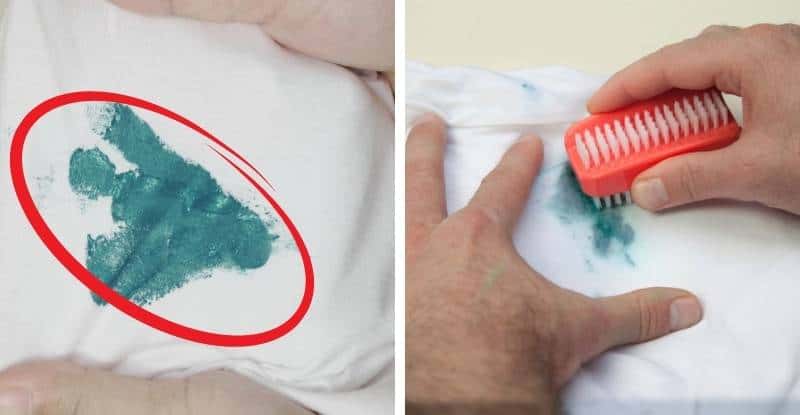Are you wondering if acrylic paint can be easily removed from windows?
Well, look no further for the answer!
Acrylic paint is known for its versatility and durability, but when it comes to windows, it can be a bit tricky.
While it may adhere well to the surface, removing it can be a challenge.
However, with the right techniques and products, you can successfully remove acrylic paint from windows without causing any damage.
Read on to discover effective methods for safely getting rid of acrylic paint from your windows.

Tips for Cleaning Acrylic Paint off Windows
Acrylic paint can be a wonderful medium to work with, allowing you to create vibrant and long-lasting artwork. However, accidents can happen, and if you have ever spilled or splattered acrylic paint on your windows, you know how challenging it can be to remove.
Luckily, there are several effective methods to clean acrylic paint off windows without causing damage. In this section, we will discuss some tips and techniques to help you get rid of those stubborn acrylic paint stains.
1. Act quickly
When it comes to removing acrylic paint from windows, time is of the essence. The sooner you tackle the stain, the easier it will be to remove. As soon as you notice the paint, grab some paper towels or a clean cloth and gently blot the excess paint. Be careful not to spread the paint further.
2. Use warm, soapy water
A simple solution of warm, soapy water can often work wonders in removing acrylic paint from windows. Fill a bowl or bucket with warm water and add a few drops of mild dish soap. Dip a clean cloth or sponge into the soapy water and gently scrub the paint stains. Rinse the cloth frequently and continue until the paint is completely removed.
3. Try rubbing alcohol or acetone
If the warm, soapy water doesn’t do the trick, you may need a stronger solvent. Rubbing alcohol or acetone can effectively dissolve acrylic paint. Apply a small amount of the solvent onto a clean cloth and gently dab at the paint stains. Be sure to test the solvent on a small, inconspicuous area of the window first to ensure it doesn’t damage the surface.
4. Utilize a scraping tool
If the paint has dried and is difficult to remove with just solvents or soapy water, you can try using a scraping tool. It’s important to exercise caution when using any scraping tool to avoid scratching or damaging the window surface. Use a plastic scraper or a razor blade angled at 45 degrees to carefully scrape off the dried paint. Always work gently and at a low angle to minimize the risk of damage.
5. Explore commercial paint removers
If all else fails, you can turn to commercial paint removers specifically designed for acrylic paint. These products can be found in hardware stores or paint supply shops. Follow the instructions on the product carefully and test it on a small area before applying it to the entire paint stain.
6. Seek professional help if needed
If you’ve tried the above methods and the paint stains persist, it may be time to seek professional assistance. Window cleaning professionals have the knowledge and expertise to handle difficult paint stains without causing damage to the window surface. They can use specialized tools and products to effectively remove the paint and restore the clarity of your windows.
In summary, cleaning acrylic paint off windows requires prompt action and the right methods. Acting quickly, using warm, soapy water, trying rubbing alcohol or acetone, utilizing a scraping tool, exploring commercial paint removers, and seeking professional help if needed are all viable options. Remember to exercise caution and test any solvents or tools on a small area before applying them to the entire stain. With the right approach, you can remove acrylic paint stains from your windows and restore their pristine appearance.

How to Safely Remove Acrylic Paint from Glass Surfaces
Acrylic paint is a popular choice for art projects and can create vibrant and stunning designs on various surfaces, including glass. However, if you make any mistakes or want to remove the paint from the glass surface, it can be a challenging task. In this section, we will guide you on how to safely remove acrylic paint from glass surfaces without causing any damage.
Materials You Will Need:
- Isopropyl alcohol
- Cotton balls or soft cloth
- Plastic scraper or credit card
- Mild dish soap
- Warm water
Step-by-Step Guide:
1. Prepare the Work Area
Start by preparing the work area to avoid any mess or accidents. Lay down some newspapers or a drop cloth to protect the surrounding surfaces.
2. Test an Inconspicuous Area
Before proceeding with the paint removal, it’s always a good idea to test a small and inconspicuous area of the glass surface to ensure that the method you are using does not damage or scratch it.
3. Remove Excess Paint
Using a plastic scraper or credit card, gently scrape off as much of the excess paint as possible. Be careful not to scratch the glass surface while doing this.
4. Apply Isopropyl Alcohol
Moisten a cotton ball or soft cloth with isopropyl alcohol. Gently dab the paint stains with the alcohol-soaked cotton ball, ensuring that the area is well-saturated. Leave the alcohol on the paint for a few minutes to loosen it.
5. Wipe off the Paint
Using a clean cloth or cotton ball, start wiping off the paint stains in gentle circular motions. If necessary, reapply isopropyl alcohol and continue wiping until the paint is completely removed.
6. Clean the Surface
Mix a small amount of mild dish soap with warm water. Dampen a clean cloth in the soapy water and gently wipe down the glass surface to remove any leftover residue from the paint removal process.
7. Rinse and Dry
Rinse the glass surface with clean water to remove any soap residue. Use a dry cloth or towel to thoroughly dry the surface.
Additional Tips:
- If the paint stains are stubborn and don’t come off easily, you can try using a glass cleaner specifically designed for removing paint.
- Always work in a well-ventilated area and avoid inhaling fumes from the isopropyl alcohol.
- Use gentle and light pressure while wiping off the paint to prevent any scratches on the glass surface.
- If you are removing acrylic paint from a painted glass surface, be cautious not to remove the underlying paint layer.
In summary, removing acrylic paint from glass surfaces can be achieved safely by following the steps outlined above. Remember to take necessary precautions, test an inconspicuous area, and work patiently to avoid any damage to the glass. With the right materials and techniques, you can effectively restore your glass surfaces to their original condition.

Quick and Easy Methods for Removing Acrylic Paint from Windows
Acrylic paint is a versatile and popular medium used by artists and DIY enthusiasts alike. However, accidents happen, and sometimes acrylic paint ends up on windows, leaving an unsightly mess. Removing acrylic paint from windows may seem like a daunting task, but with the right methods and tools, it can be done quickly and easily. In this section, we will explore some effective techniques for removing acrylic paint from windows.
Gather the Necessary Supplies
Before you begin the paint removal process, it’s important to gather all the necessary supplies. Here’s what you’ll need:
- Plastic scraper or credit card
- Paper towels or soft cloth
- Mild dish soap
- White vinegar
- Water
- Cotton balls or swabs
- Rubbing alcohol
- Gloves to protect your hands
Method 1: Scraping and Soapy Water
If the paint is still wet or relatively fresh, this method can be quite effective. Follow these steps:
- Start by gently scraping off as much paint as possible using a plastic scraper or credit card. Be careful not to scratch the glass surface.
- Next, prepare a mixture of mild dish soap and warm water.
- Dip a soft cloth or paper towel into the soapy water and gently scrub the painted area. Use circular motions to loosen the paint.
- Rinse the window with clean water and dry it thoroughly with a soft cloth or paper towel.
Method 2: Vinegar Solution
If the acrylic paint has dried, a vinegar solution can help break it down. Follow these steps:
- Mix equal parts of white vinegar and warm water in a spray bottle.
- Spray the vinegar solution directly onto the painted area and let it sit for a few minutes to soften the paint.
- Using a plastic scraper or credit card, gently scrape off the loosened paint. Be careful not to apply too much pressure to avoid scratching the glass.
- Wipe away any remaining residue with a clean cloth or paper towel.
- Rinse the window with clean water and dry it thoroughly.
Method 3: Rubbing Alcohol
Rubbing alcohol can be an effective solvent for removing acrylic paint from windows. Here’s how to use it:
- Take a cotton ball or swab and soak it in rubbing alcohol.
- Gently dab the alcohol-soaked cotton ball onto the painted area. Let it sit for a few minutes to allow the alcohol to penetrate the paint.
- Using a plastic scraper or credit card, scrape off the softened paint. Be gentle to avoid damaging the glass surface.
- Wipe away any remaining residue with a clean cloth or paper towel.
- Clean the window with a mixture of mild dish soap and warm water to remove any alcohol residue.
- Rinse the window with clean water and dry it thoroughly.
Additional Tips and Precautions
Here are some additional tips to help you effectively remove acrylic paint from windows:
- Always wear gloves to protect your hands from harsh chemicals or abrasive materials.
- Test any cleaning solution or method on a small, inconspicuous area of the window first to ensure it does not damage or discolor the glass.
- Work in a well-ventilated area to avoid inhaling fumes from cleaning products.
- For stubborn or dried-on paint, you may need to repeat the process or use a combination of methods.
- Use gentle, circular motions when scrubbing to avoid scratching the glass surface.
Summary
Removing acrylic paint from windows doesn’t have to be a difficult task. By following the methods outlined above and using the right tools and supplies, you can effectively remove the paint and restore the clarity of your windows. Whether it’s scraping and soapy water, a vinegar solution, or rubbing alcohol, choose the method that suits your needs and give your windows a fresh,
Preventing Acrylic Paint Stains on Windows: Proven Strategies
Acrylic paint is a popular choice for artists and DIY enthusiasts due to its versatility and vibrant colors. However, one common challenge that comes with using acrylic paint is preventing stains on windows. Accidental splatters or smudges of paint on windows can be frustrating to remove and may result in permanent damage if not addressed promptly. In this section, we will explore some proven strategies to prevent acrylic paint stains on windows.
1. Preparation is Key
Before starting any painting project, it is crucial to prepare the area properly, especially when working near windows. Here are some preparation steps to follow:
- Cover the window frames and surrounding areas with plastic sheets or masking tape. This will create a barrier and protect the glass from paint splatters.
- Ensure that the windows are clean and free from any dust or debris. Use a mild window cleaner to remove any dirt or grime.
- Consider applying a layer of painter’s tape along the edges of the window glass. This will provide an extra layer of protection and make cleanup easier.
2. Use a Protective Barrier
In addition to preparing the area, using a protective barrier can significantly reduce the risk of acrylic paint stains on windows. Here are two effective options:
- Apply a thin coat of petroleum jelly or baby oil to the window glass using a clean cloth. This creates a barrier between the paint and the glass, making it easier to remove any accidental splatters.
- Consider using a liquid masking film specifically designed for windows. These products can be applied directly to the glass and peeled off once the painting is complete, leaving no residue behind.
3. Work with Care and Precision
When painting near windows, taking extra care and working with precision can go a long way in preventing stains. Here are some tips to keep in mind:
- Use a smaller brush or a detailed brush for areas close to the window glass. This allows for better control and minimizes the chances of accidental paint splatters.
- Apply paint in thin layers rather than thick coats. Thick coats are more likely to drip or splatter, increasing the risk of stains on windows.
- Wipe off any excess paint from the brush before approaching the window. This reduces the likelihood of paint dripping or transferring onto the glass.
4. Promptly Address Accidental Splatters
Despite taking precautions, accidents can still happen. If you notice any accidental paint splatters on the windows, it is essential to address them promptly. Here’s what you can do:
- Immediately wipe off the wet paint using a damp cloth or paper towel. Be gentle to avoid spreading the paint further.
- If the paint has dried, use a razor blade or a plastic scraper to carefully scrape off the dried paint. Be cautious not to scratch the glass surface.
- If the above methods do not fully remove the paint stains, consider using a commercial paint remover specifically formulated for acrylic paint. Follow the instructions provided by the product and test it on a small, inconspicuous area before applying it to the entire window.
In summary, preventing acrylic paint stains on windows requires careful preparation, the use of protective barriers, working with precision, and promptly addressing any accidental splatters. By following these proven strategies, you can enjoy your acrylic painting projects without worrying about damaging your windows.
FAQs
Does acrylic paint come off windows?
No, acrylic paint does not easily come off windows. Once it dries, it forms a permanent bond with the surface. To remove acrylic paint from windows, you can try scraping it off with a razor blade or using a commercial paint remover specifically designed for acrylic paints.
Conclusion
In conclusion, acrylic paint can be removed from windows with the right techniques and materials. Whether it’s a small accidental paint splatter or a larger art project gone awry, there are solutions available to help you restore the clarity of your windows. Using a combination of warm soapy water, a razor blade, and rubbing alcohol can effectively remove acrylic paint from glass surfaces. However, it is important to test the method on a small, inconspicuous area before applying it to the entire window. With some patience and careful application, you can successfully remove acrylic paint from windows and restore their original appearance.
